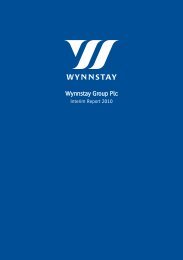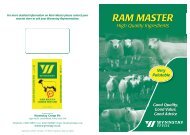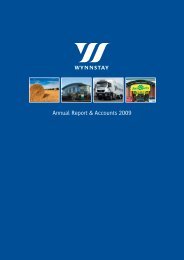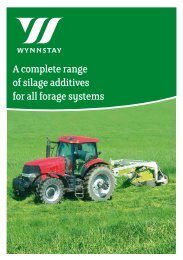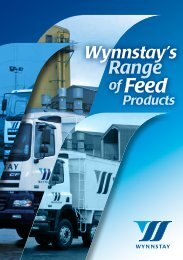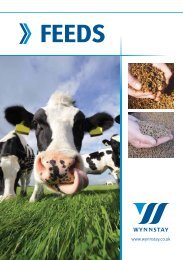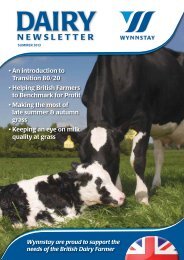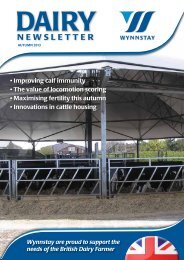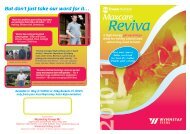Dairy
N e w s l e t t e r - Wynnstay
N e w s l e t t e r - Wynnstay
- No tags were found...
You also want an ePaper? Increase the reach of your titles
YUMPU automatically turns print PDFs into web optimized ePapers that Google loves.
of ice into the bucket of colostrum, and store in a fridge 1-2°C for up to 7<br />
days. Never let colostrum sit at room temperature, it is an excellent breeding<br />
ground for E Coli and other pathogens. The E Coli population doubles every<br />
20 minutes at body temperature! The addition of calcium formate will help<br />
inhibit bacterial growth.<br />
Testing<br />
There is little point in freezing & saving poor quality colostrum. Testing is<br />
important as ‘only the best will do’ as a first feed. Test colostrum for its<br />
antibody status. This can be done either with a Colostrometer, or a Brix<br />
refractometer. The colostrometer is the cheapest cow side method, but<br />
the refractometer is more expensive and robust. Good colostrum will<br />
register ‘green’ on the colostrometer (> than 50mg Ig/ml) or + 22 on the<br />
refractometer.<br />
Colostrum which registers ‘green’ on the colostrometer can be saved in the<br />
freezer. ‘Perfect Udder’ storage bags (3.8 litre) or flat plastic bags are the<br />
easiest to defrost. The ‘green’ can be fed on Day 1 The ‘red’ colostrum can be<br />
saved in the fridge for feeding on Days 2 to 5.<br />
Fridge or freezer?<br />
Store in the fridge at 0-4°C for a week or in the freezer at -20°C for up to a<br />
year. Label the sample with Ig level and date.<br />
Thawing - be careful - antibodies are destroyed by over-heating (cooking).<br />
Thaw slowly in a warm water bath at maximum of 60°C. Use a floating dairy<br />
thermometer to regulate temperature of the water bath<br />
Colostrum Corner<br />
The effect of poor colostrum management has such a huge impact on farm<br />
profitability that it warrants a separate corner in the dairy kitted out with<br />
all the tools for the job i.e. sink, fridge, freezer, funnel, bags, thermometer,<br />
Colostrometer and water bath.<br />
There is now a commercial system developed in Denmark, marketed by<br />
Holm & Laue through Wynnstay. The Coloquick system will help with testing,<br />
harvesting and thawing within 15 minutes of birth. The Coloquick water<br />
bath is also available as a colostrum pasteuriser. Following the suggested<br />
colostrum harvesting and storage plan makes life easier for the calf rearer<br />
and gives every calf the chance of a flying start. The system is widely used in<br />
Denmark and increasingly in the UK.<br />
For those who are trying to manage Colostrum on a tight budget, the<br />
Wynngold Colostrum management Kit is a good place to start.<br />
1<br />
2<br />
The COLOQUICK System<br />
3<br />
5<br />
4<br />
6<br />
WHEN A COW CALVES<br />
1. Milk the cow and check for antibodies with a<br />
Colostrometer. ‘Green ‘ is the best quality<br />
2. Place the bag in the cartridge<br />
3. Good quality colostrum can be poured into the Coloquick<br />
bag, poor quality can go in the fridge or freezer for feeding<br />
on days 2,3,and 4<br />
4. Place cartridge in the freezer<br />
WHEN A CALF IS BORN<br />
5. Take cartridge out of the freezer<br />
6. Put in the Coloquick machine to thaw<br />
7. Colostrum is defrosted and warmed in 15-20mins<br />
8. Cartridge can be attached to an<br />
oesophageal feeder<br />
9. Or the calf can be fed by teat<br />
10. No problem with the calf drinking 4 litres if its good<br />
quality AND the right temperature<br />
7<br />
8<br />
A pasteuriser model is also available.<br />
9<br />
10<br />
Gill Dickson<br />
National Calf Specialist<br />
M: 07971 296702<br />
gill.dickson@wynnstay.co.uk<br />
Wynnstay Group Plc <strong>Dairy</strong> Newsletter Spring 2013 7



